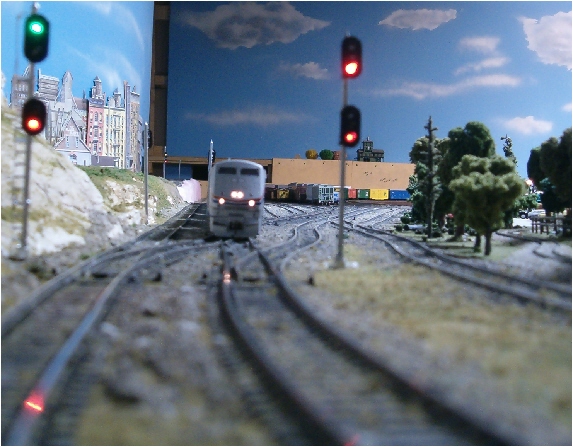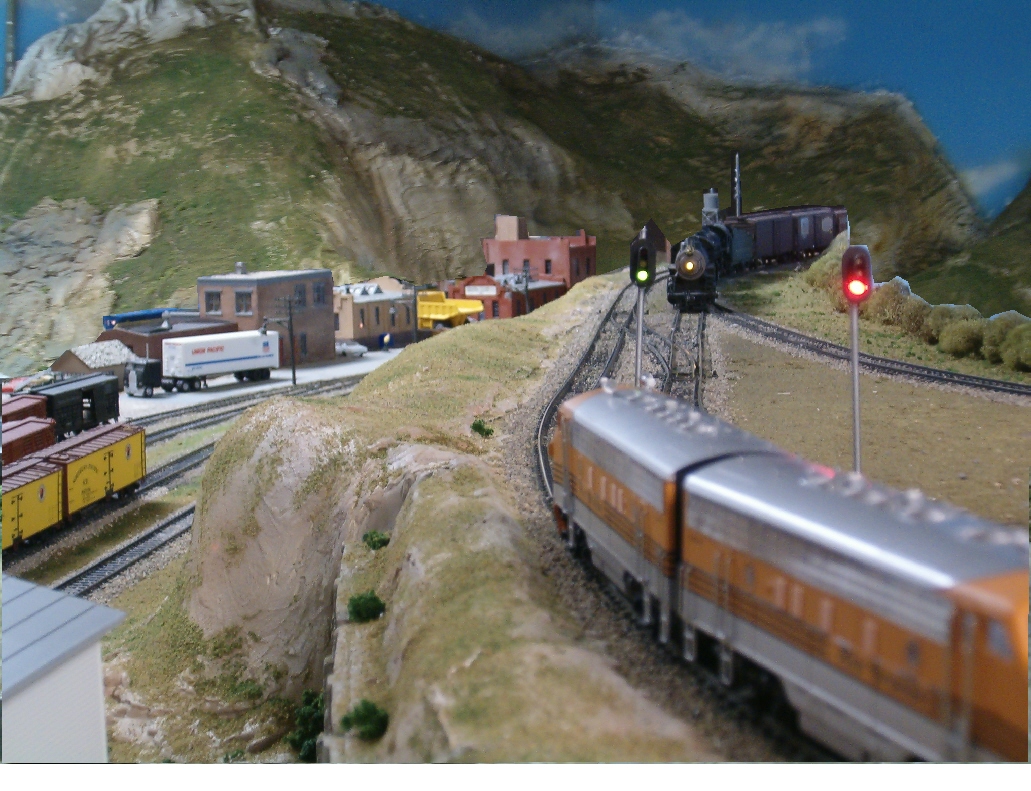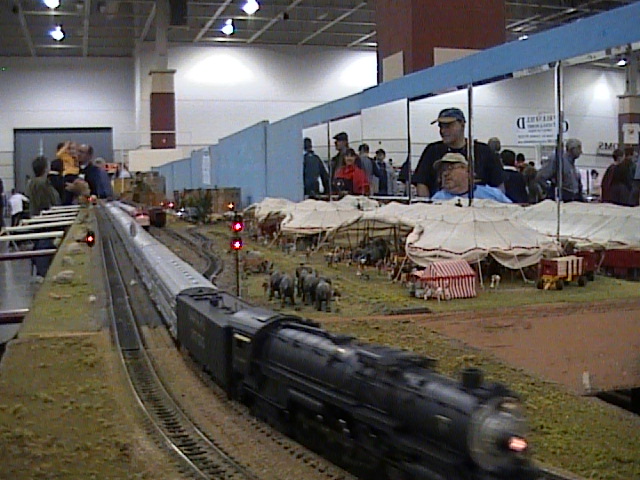HOME CALENDAR OF EVENTS LOCOMOTIVE TYPES SIGNALING DCC MODULAR LAYOUT MEMBERS MEMBERSHIP APPLICATION OUR HISTORY LAYOUT TOUR FALLEN FLAGS CONSTITUTION
Signaling on the S&WRR
ATSF
Dual Track ABS Signaling ![]() Signaling
overview
Signaling
overview ![]() SE8C
& RR&Co
SE8C
& RR&Co ![]()
Signaling
on our Modular Layout ![]()
Once we had reached the stage where we had a computer tied to the layout and Railroad & Co. software operational, we saw a need that we could fill for the operators (engineers) to know what the dispatcher knew, namely where everybody else was. This was due to the fact that there are many view blocks due to scenery and backdrops, with no more than 20 to 25 feet of track ahead being visible from any one vantage point. As a result, one could not tell what was ahead unless there was a visual indication. This is a walk-around layout, thus the operators follow their trains. Because the software was capable of not only tracking train locations, but also setting turnouts and signals accordingly, we decided to add fully operational APB* signaling. It is based on the ATSF dual track standard, except that both mainlines are signaled bi-directional (Tumble-down). Nearly 50 signals are now in place.
*APB=Automatic Permissive Block
|
A train meet near the power plant (note the high tension lines) with a westbound B&O passenger train and an eastbound local freight. The signals change automatically, controlled by the computer, based on block occupancy and routes. |
In the picture above the freight is seeing a green signal, so it continues on its way, but if that signal was red, the train would have stopped, if yellow it would slow to restricted speed. This way it is impossible for two trains to meet unexpectedly. The signal opposing the oncoming passenger train is correctly showing red, as are all others until the next siding.
With bi-directional signaling, the aspects displayed in a particular direction will vary depending on what direction a train is traveling. For example, a train traveling east will see green until it reaches occupied blocks or turnouts thrown against it. In the opposite direction all signals would show red to the next siding. This is possible because the computer, which controls the signals, knows not only where trains are, but which direction they are traveling.
Because the software knows where every train is located, as well as the position of all turnouts, we added an additional failsafe. If the operator is not watching the signal ahead of his train, and approaches a red light, the computer automatically takes control of the train and stops it until the signal changes to green. It then restarts the train at the previously set speed and transfers control back to the operator. This failsafe does not apply to yards and industrial areas, where locos are moving around and operators are expected to be watching what they are doing. If the signal was yellow, the software reduces the speed to the restricted speed for that block.
As soon as we installed the first set of signals, we quickly realized how valuable a tool this was for safe operation. With more than four dozen signals now installed, and operators getting used to them, mishaps have been greatly reduced. An added bonus was how much they added to the visual appeal of the layout.
 |
|
Double headed signals control the north throat of the Proviso Yard as an Amtrak train works its way though this area. The signal logic here was complicated by all the possible routes in and out of this yard. |
Because of the huge quantity of signals needed (60), we built our own from scratch, using materials from Loys Toys. We also found that a number of situations required custom signals not commercially available. You can't find a working double track bi-directional signal bridge anywhere, as was needed in several locations. An assembly line of sorts was set up to accommodate mass production of many signals at once. Besides being quicker, they could be customized easier during final assembly.
On our modular layout, which is setup as a display layout as opposed to operations, we handled things differently. Because it has to be assembled and come apart easily, the approach to detection and signaling was handled quite differently on the modular layout than it would be on a permanent setup. Each module set became an independent operating unit, linked together with cables that plug in after assembly.

Another example of some signals. A D&RGW passenger train roars past South Middleton, a bustling community of light industry, heading for Sacred Mountain in the background. Using a 6:1 fast clock, it will take that train another two hours to reach it. |
We are using the Digitrax© SE8C signal control boards. They, in turn, connected to Loconet, are given commands from the computer running Railroad & Co. Train Controller®. TC gets information from block detectors and turnouts around the layout. Using the signaling logic set up in the program, the aspects of each signal are set automatically based on block occupancy and routes.
 |
|
Signaling on our modular layout is handled a little differently. Using all Digitrax equipment, but keeping it modular was a real challenge. It has been a joy to show other modelers that it can be done, and how. It has been a hit at many shows. |
Originally, we set it up using four aspects (Red, Yellow, Flashing Yellow, Green) for all signals. That way, to get a Green signal, at least three blocks ahead of a train had to be clear. We found that during one Open House that this created some bottlenecks at times. As a result we have changed it to three aspects, reserving the Flashing Yellow for only special situations such as a crossover ahead is thrown, a train is about to take a siding, or a train is about to enter a reverse loop. It opened up traffic a little more, and at the same time created less confusion about what the Flashing Yellow meant. A visit to the layout at the Museum of Science and Industry in Chicago convinced us to make that change.
When we have a formal operating session, strict compliance with established rules are observed. Engineers must wait for clearance before proceeding. They must also obey all signals. No free-lanced operation here. During Open Houses the computer takes over and operates the layout. Trains are run on preset schedules and safety features are built in to prevent trains from passing a red signal.
Take a tour
Photos and text on this site are © 1977 - 2018 Sheboygan Society Of Scale Model Railroad Engineers, Ltd. All rights reserved.
Updated: Tuesday, August 21, 2018